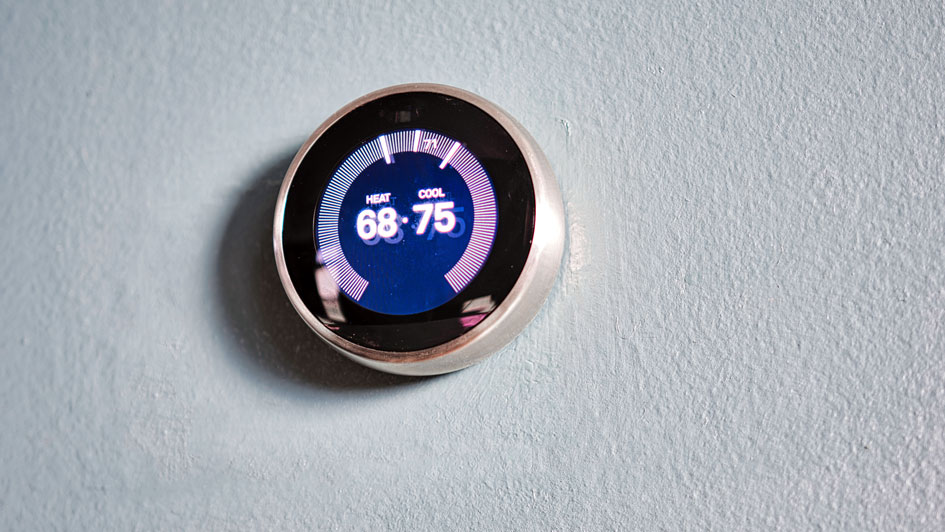
A Nest Thermostat is a great investment for keeping your home comfortable, regardless of the season or weather. With a number of innovative features meant to maximize efficiency, convenience and comfort, a Nest Thermostat is an easy way to manage your energy use — saving you money in the process.
That’s why more people are looking to add devices like a Nest to their homes. To add one to your home, get in touch with an expert for smart thermostat installation in Hodgenville.
From auto scheduling to optimizing energy efficiency, Nest helps make home climate control effortless.
Want all the details? Take a look at 12 things you should know about your Nest Thermostat.
1. How to Reset a Nest Thermostat
A key piece of information to know about resetting a Google Nest Thermostat is that resetting is different from restarting.
- Restart: Similar to restarting any electronic device, including your phone or computer, restarting your Nest Thermostat turns it off before starting it right back up again. This records your existing thermostat settings, ad can reapply them once you're done confirming if your Nest is frozen or not connecting to Wi-Fi.
- Reset: A reset erases some or all of your settings. People normally only use a reset when they’re moving to a new home and bringing the thermostat with them, or if they just want to erase all personal info from the Nest before leaving it for the next homeowner.
If you want to perform a reset, it helps to record existing temperature settings so you have them if they get erased. Next, find Settings -> Equipment and write down the details about your system wires, heating type and safety temperature settings.
After writing down this information, go to Settings, select Reset and press. You can choose from five options:
- Restart: Shuts your Nest down and starts it back up while remembering your settings. You can also press the outside of the Nest and hold it there until it goes black, and then pull your hand away.
- Schedule: This type of reset clears all scheduling information—including for your hot water, if that has been connected to your Nest. With this option, you’ll need to create a new schedule or wait until the Nest learns your schedule.
- Away: An Away reset removes anything your Nest has learned about how often you walk by, so it will be able to change the temperature even when you're not around.
- Network: If you select this reset option, it erases connection info and your Nest will no longer be connected to Wi-Fi. It also forgets your Wi-Fi password.
- All Settings: The most far-reaching option, using the All Settings reset option removes all your personal settings and learning.
2. How to Connect Nest Thermostat to Wi-Fi
A stable internet connection is important if you want the most use of its online features.
To connect your Nest to the internet:
- Turn the thermostat ring to the Quick View menu.
- Find the Settings icon.
- Select Network.
- Once your Nest has scanned nearby networks, locate your Wi-Fi and, if you have one, enter your password.
3. Does a Nest Thermostat Use a Battery and How Long Will the Battery Last?
Nest thermostats get the power they need directly from your HVAC system, but each one also features a rechargeable lithium-ion battery for backup in case of a power outage. According to Google, who manufactures the thermostat, a Nest Thermostat battery last an average of several months. The Nest's battery is rechargable with a USB cable included with the thermostat.
4. How to Turn Off a Nest Thermostat
If you won't be home for a while, consider setting your Nest Thermostat to Off mode, though Eco mode would be another option. Using Off mode will turn off all of your regular heating and cooling schedules, but it will still adhere to any current Safety Temperatures to keep your home from getting especially hot or cold.
To find Off mode on the thermostat:
- Press and hold the touch bar until it displays “Turn Off” before sliding the bar to highlight Turn Off, and then touch the bar to select.
- You can also go to Mode from the main menu and select Off.
Off mode is available on the Google Home app as well:
- Select Thermostat from home screen
- Tap Temperature mode
- Select Off
5. Can Alexa Control a Nest Thermostat?
Yes, Amazon's Alexa is compatible with a Nest Thermostat. Alexa voice controls are also available with Nest doorbells and cameras. And of course, you can use Google Assistant to control your Nest.
6. Can a Nest Thermostat Work Without Wi-Fi?
Yes, your Nest Thermostat will still be able to adjust the temperatures without Wi-Fi. At the same time, a lack of an internet connection means your Nest doesn’t have the smart thermostat functions that most people enjoy.
7. Are You Able to Lock a Nest Thermostat?
If different members of your family can't agree on the ideal temperature, Nest offers a handy feature that keeps things simple.
Users can lock the Nest to prevent others from adjusting the settings or changing the temperature outside of a preset range. This won't mean you have to make do with just one temperature—a locked Nest continues to use existing program settings—but simply prevents people from changing the settings.
If you want to lock your Nest:
- Tap the Settings icon, scroll to the bottom and find Lock.
- Enter a 4-digit pin number you can remember, and do so twice.
- If locking in Heat or Cool mode, fine-tune your maximum and minimum temperature range and then tap Lock at the bottom of the screen.
For unlocking it, open the settings and choose Unlock. As soon as you've provided your 4-digit pin, the Nest will be unlocked.
8. Adjusting a Nest Thermostat from a Phone
You can control the Nest through your Google Home app, accessible through your phone or other smart device, including a computer. Other versions of Nest, including the Nest Thermostat E and Nest Learning Thermostat, can also be controlled remotely by the Nest app.
Before you can control a Nest on your phone with Google Home or the Nest app, you need to follow a few steps:
- Download the Google Home app or, with premium Nest models, the Nest app to your phone.
- Hook up your Nest Thermostat.
- Access the Google Home app on your phone and complete the setup process, link to your new device and connect to Wi-Fi.
- Google offers a more in-depth setup tool, if you prefer additional assistance in connecting.
After you've added the Nest to your Home app, it's accessible by clicking Thermostat on the home screen. Once you do that, you can change your Nest temperature by dragging your finger along the screen or tapping on a plus or minus sign.
The app also allows you to change the Nest's preset temperatures. From the home screen, find your Thermostat before selecting Settings. Once there, press Temperature Preferences and then Temperature Presets. The display will show your preferred Comfort, Eco and Sleep temperatures. Select one of these options to change the temperature for that preset.
9. Setting a Nest Thermostat Schedule
Your Nest allows you to schedule temperature programming either on the device or on the Google Home app. Newer and advanced models of the Nest, such as the Nest Thermostat E and Nest Learning Thermostat, also can be controlled via the Nest app.
The two easiest ways to schedule your Nest are:
- Quick Schedule: The Quick Schedule feature is based on the national average schedule for energy efficiency. As you set the thermostat up, the Google Home app gives you the option to change the temperature with a schedule. If you select this feature, it displays a preset schedule for you to customize as you wish. Once setup is complete, that’s the schedule it will use.
- Temperature Presets: For changing the Nest's preset temperatures, open the Google Home app and select Thermostat. Then, tap Presets and choose Edit. Once you’ve made the changes, select Done.
To make tweaks or changes to your current schedule, open the Google Home app, select Thermostat and then tap on Schedules. You can then pick the day of the week that you want to add a temperature. Once you pick the day, tap Add and select the preset you want. Finally, select Time before touching and dragging the numbers to change the time. Select Done to save changes.
10. Setting a Temperature Range on a Nest Thermostat
Your Nest's Eco mode is great for setting temperature ranges. Your Nest will adjust the temperature depending on if you're at home or away.
To customize the Nest temperature range in Eco mode, go to Settings and select Eco. The thermostat's display should list existing “Heat to” and “Cool to” temperature settings. You can select each and make your preferred changes. Once you're finished, select Done.
11. What Should I Do If My Nest Thermostat Isn't Compatible?
A Nest Thermostat is compatible with most HVAC systems. Google, Nest's manufacturer, features a compatibility checking tool that asks a series of questions about your location and current setup to learn which Nest model would be compatible with your system.
If you have a Nest and believe it’s not compatible with your system, it’s best to reach out to a professional for smart thermostat installation in Hodgenville. Technicians with the proper experience can assess your system and, if your Nest is compatible, install it quick so you can jump right into the savings and convenience.
12. Can I Manually Control My Nest Thermostat?
Nest Thermostats are loaded with innovative features designed to make life more comfortable and save money. However, you can actually turn off the smart features if you prefer manual controls similar to normal thermostats.
Remember, by doing this you are turning off all of your temperature schedules and your Nest will work like any other thermostat—it will display the temperature and let you change the temperature, but that’s about it.
You can achieve this by disabling the settings in a series of steps:
- Auto-Schedule: From the main screen, go to Settings and then scroll to Nest Sense. Go to Auto-Schedule, select No and click Done.
- Eco: From the main screen, go to Settings, scroll to Eco. Once in Eco, select Off for both the Heat to and Cool to temperatures, and select Done.
- Home/Away Assist: From the main screen, go to Settings and select Home/Away Assist. Then, select Stop Using and click Done.
- Reset: After you've cleared the settings, reset your nest. From the main screen, go to Settings and select Reset, highlight Schedule and then select Reset to clear out any saved scheduling data.



